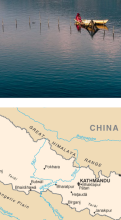"Destination Nepal. For many travelers, Nepal is paradise on Earth, or at the very least Shangri La. Wedged between the mountain wall of the Himalaya and the steamy jungles of the Indian plains, this is a land of yaks and yetis, monasteries and mantras, snow peaks and Sherpas, temples and tigers, magic and mystery. Ever since Nepal first opened its borders to outsiders in the 1950s, this tiny mountain nation has had an almost mystical allure for travelers. Explorers and mountaineers came to conquer the highest peaks, trekkers came to test themselves against some of the most challenging trails on earth and hippies came to wander in a stoned gaze through the temple-filled towns at the end of the overland trail." (Lonely Planet Nepal 2009)
Nepal evokes different images to trekkers the world-over. As the 2009 Lonely Planet Nepal travel guide notes above, Nepal holds wide appeal and offers something for everyone. What this quote doesn't tell us, however, is that Nepal ranks 149th on the Human Development Index and struggles to provide its people access to education, healthcare, and livelihood opportunities. Its GDP, despite being heavily dependent on tourism, is reliant on the wages sent home by Nepali workers abroad. Nepal is also in the throes of social and political change following a decade-long civil war, devastating 2015 earthquakes, and a new constitution. In this 22-day exploration seminar, we examine how the sometimes competing forces of tourism and development are shaping modern day Nepal. A key phenomenon that exemplifies these tensions is the newly-built road in the Annapurna region that leads to Mustang. The road is the artery of the region: trucks now bring goods to trade in markets, jeeps ferry locals to bigger cities with educational and livelihood opportunities, and construction vehicles move land and materials to make way for new hospitals. The road also enables deep-pocketed tourists to travel into the mountains with ease, marveling at the alpine beauty, visiting pilgrimage sites, and directly encountering "traditional" cultures. The road opens access to communities with complex socio-linguistic ties to Tibet, bringing pollution, noise, outsiders, and new markets. Who does this road benefit and how is it shaping geo-topographies of culture and community? How are local communities jockeying for position to exploit newly-found resources?
Road to Mustang: Tourism and Development in Nepal Himalaya exploration seminar is a new interdisciplinary program at the University of Washington. Students will get introductory training to ethnographic and anthropological observation methods, essentially giving them a toolkit to explore these issues. At the same time, this innovative study abroad program has as a primary goal for students to engender a sense of critical humility as emerging global citizens. The program has 4 learning objectives: gain an expanded understanding of some of the social, cultural, and political-economic issues affecting tourism and economic development in Nepal; be able to critically analyze current debates on--and approaches to--tourism and development; be able to differentiate among the key stakeholders, partners, and viewpoints in Nepal's tourism and development sectors; and develop introductory ethnographic and anthropologic observation skills.
Anthropology Nepal: Road to Mustang: Tourism and Development in the Nepal Himalaya
Complete Program Information
Program Status
Inactive/Archived
